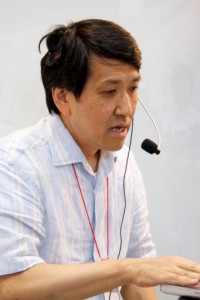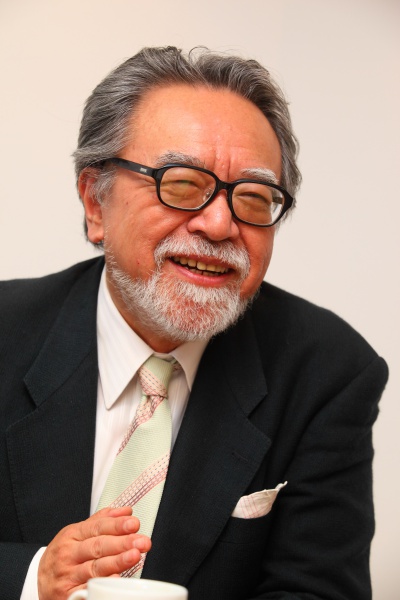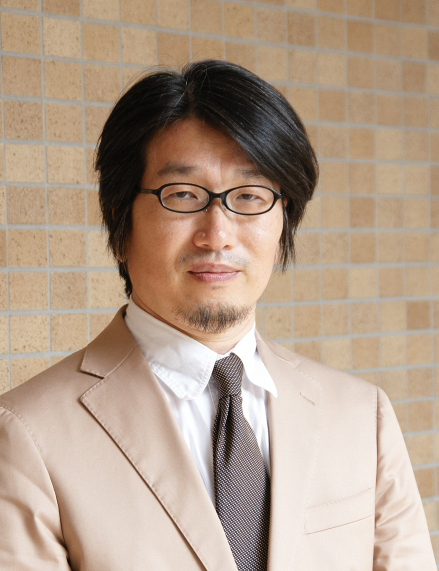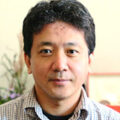The Blue Sky Library: Tomita Michio’s Dream of a Disciple Outshining His Teacher
A memorial symposium titled “The Dream of Aozora Bunko: The Future of Copyright and Culture” was held at the Tokyo Bunka Kaikan hall on September 25, 2013, in memory of Tomita Michio, the person who initially proposed Aozora Bunko (hereinafter referred to as the “Blue Sky Library”). This event was sponsored by the Tomita Michio Memorial Event Executive Committee (co-chairpersons: Tomita Akiko and Yamaki Mie of the Blue Sky Library) along with the Blue Sky Library, Voyager Japan, Inc., Movements for the Internet Active Users (MIAU), Creative Commons Japan (a nonprofit corporation commonsphere) and ThinkC (a forum for discussing an extension of the copyright protection period). Niconico’s Internet broadcast service broadcast the symposium proceedings live on the Web. The proceedings are also available as archive videos on niconico’s website (*1).
Tomita Michio, the Blue Sky Library, and the Future of Books Fund

Tomita michio at the event “The Blue Sky Library, with 800 Volunteers and 10,000 e-book Titles” held by Voyager Japan, Inc., in July 9 2011.
Courtesy of Voyager Japan, Inc.
The voice and image of Tomita reciting Akutagawa Ryunosuke’s Kosei (“Ages to Come”) was broadcast at the beginning of this memorial event. Recorded at an emergency symposium held on June 29, 2013, titled “How Should Japan Negotiate the TPP?—Will 70 Years after Death and Decriminalizing an Offense Indictable Only upon Complaint Enrich the Culture and Strengthen the Economy?” (*2), the videotaped recitation was the last speech Tomita made in public before his death.
Following the video, Noguchi Yuko of Creative CommonsJapan talked about Tomita’s career. Born in HiroshimaCity in 1952, Tomita was an author and editor who received a bachelor’s degree in political science from WasedaUniversity. His major works included Pasokon Soseiki (“Personal Computer Genesis”) and Hon-no Mirai (“The Future of Books”). Tomita founded the Blue Sky Library with several of his friends in 1997.
The Blue Sky Library is an online Japanese digital library (*3) that volunteers support by entering and proofreading text. Users can read, duplicate, and redistribute all works in the Library that are out of copyright free of charge without permission. About 200 volunteers are currently registered with the Library, which includes 12,176 published titles. Major e-book stores are using the Blue Sky Library as a means of content distribution. Books in the Library are also used as original texts for teaching materials, recitations, reading services for the sight-impaired, braille literature, and books printed in large type.
As a representative of the Blue Sky Library, Tomita issued a public statement on January 1, 2005, announcing that the Library “opposes the extension of the copyright protection period to 70 years.” The next year, Tomita helped to found ThinkC. As his activities show, he was a tireless advocate. Tomita died of liver cancer on August 16, 2013. He was 61.
Hon-no Mirai Kikin (hereinafter referred to as the “Future of Books Fund”) was established on September 15, 2013 as a source of funding for this memorial event and the future activities of the Blue Sky Library (*4). As of September 24, 2013, the Future of Books Fund had raised 2,019,000 yen (1,928,133 yen excluding PayPal service fees), including 4,307,000 yen in financial sponsorship from 41 organizations and unspecified donations from 206 individuals. As ways of using this reserve, Fund officials are considering ideas such as outsourcing proofreading for books waiting for publication, manually producing and supporting the development of supporting tools, and building and developing websites.
The Conviction that Knowledge Belongs to Everyone
Following Noguchi, Nagao Makoto, a former director of the National Diet Library and the former president of KyotoUniversity, delivered a keynote speech based on the theme of “The Age of Electronic Libraries.”
Nagao studied at KyotoUniversity out of a wish to “find the ideal library.” In 1996, he published an electronic library prototype in a library linked to KyotoUniversity (*5). This prototype could do a lot more things than simply manage individual books. It was equipped with functions such as the ability to extract favorite book sections and link them to other publications, automatically recite text on e-book terminals, conduct dictionary searches, insert commentary, and automatically translate text. However, Nagao says, people didn’t accept his prototype because it was ahead of its time.
Nagao was appointed director of the National Diet Library in 2007. At that time, he was considering creating an electronic library at the National Diet Library that offered equal access to everyone across Japan as it should, as citizens pay for the Library’s expenses with their tax dollars. However, many barriers stood in the way of realizing this electronic library. Copyrights turned out to be an obstacle in digitizing books. Nagao approached the relevant authorities to amend the law. As a result, the National Diet Library became able to digitize books without requiring copyright permission, and a system for depositing copies of electronic books was established at the Library (*6).
The National Diet Library also gained the ability to archive information that the central and local governments had published on the Web, without requiring permission. The Library had digitized 2,100,000 copyrighted titles, but people couldn’t read them unless they came to the Library in person. In view of this situation, Nagao made arrangements to distribute archived books to public libraries throughout Japan over the Internet. He also set up a portal website to search digital data on the Great East Japan Earthquake (*7). Along with books, the National Diet Library is reportedly archiving materials such as historical recordings (*8), as well as scripts and plays, which tend to be scattered and lost after broadcast.
Digitizing the 2,100,000 titles in the National Diet Library required a budget of 12 billion yen. The Library currently has a total of approximately 40,000,000 publications. Among these, about 9,000,000 books and magazines need to be digitized. In other words, the National Diet Library requires an additional budget of 40–50 billion yen. Such a sum is very difficult to obtain. For that reason, a long-term strategy is indispensable, says Nagao.
Nagao is convinced that knowledge belongs to everyone. In concluding his speech, he said he believed that Tomita shared this conviction.
Looking for New Sailors on a Journey in Search of a Disciple Who Outshines His Teacher
After Nagao, President and CEO of Hagino Masaaki of Voyager Japan, Inc., spoke about “The Course and Achievements of the Blue Sky Library.” “What do people leave behind after they die?” Hagino asked.
Voyager is a commercial company, but Tomita had reportedly had a much greater ambition to appeal to the social nature of electronic publishing. There is a huge difference between trying to make a profit and what Tomita tried to do. However, Hagino recalled that he and Tomita had agreed on the overall objective of popularizing electronic publishing.
“What is this thing called the Blue Sky Library that Tomita left behind? Instead of being forced to list its virtues in that way, I would like Tomita to show up here in person and explain them.” After saying this, Hagino introduced video footage of Tomita shot at the e-Book Expo Tokyo, where he served as a discussion panelist in 2011 and 2012 (*9).
After showing this footage, Hagino explained how the Blue Sky Library was started. Tomita came across Apple’s HyperCard around 1990. According to Hagino, this experience was what led Tomita to the Blue Sky Library. He reportedly thought that the tool “could change the world of books.” Looking back, Hagino says that Tomita kept asking him up until he died to think about what it would mean to create “another world of books” alongside the world of printed books, because by that point he could see the possibilities of electronic publishing, or the possibility of being able to produce books on a computer by himself.
According to Hagino, two big symbolic events took place after the Blue Sky Library was launched. First, visually impaired people contacted the Library after it launched the service, letting them know that “these are books we can read.” Hagino says this made him realize for the first time that the books printed on paper he had pictured up till then contained sentences mainly targeted at young and sighted people.
The other big development is believed to be Yamagata Hiroo’s criticism that the “Blue Sky Library is pathetic.” “I thought this was an extremely valid criticism,” Tomita said in the video footage introduced at the symposium.
“Users will find our files difficult to access unless we clearly define what they can and cannot do with them,” Tomita noted. “Unless we do that, these files will not be put to practical use as public resources.”
Following this criticism, the Blue Sky Library reportedly began disclosing information more fully to users, under the belief that simply producing text was not enough. Volunteers made a continuous effort to make the books in the Blue Sky Library available to everyone all the time, providing information about the original text in the Aozora Chuki (“Blue Sky Notes”) column, establishing themselves as typists and proofreaders, and creating an XHTML conversion program. These efforts have resulted in the current collection of 12,176 titles.
Those who remember Tomita say that he often said, “A disciple must outshine his teacher.” “A disciple must start by imitating his teacher,” he said in the video footage shown at the symposium. Electronic books were born out of an effort to imitate printed books. Although they are in an excellent format, printed books have their limits, such as not being accessible to the visually impaired and their inability to be delivered on demand.
Tomita used to say that the Blue Sky Library “can realize a bluer sky” than what printed books had achieved by establishing conditions for electronic books that are born out of printed books. He also said, “We have old sailors on an old boat now. But we are looking for new sailors to arrive in order to reach a bluer sky.”
Hagino wrapped up his speech with the following remark: “Tomita was the person next to you who actually practiced the spirit stated at the beginning of the Copyright Act. We have lost someone precious.”
-------------------------------------
Editor’s Note: Voyager Japan, Inc., an electronic publisher, has posted a pamphlet on its website that presents the company’s history and philosophy. The 2011 edition of the Voyager Pamphlet, The Long Voyage Home, includes “Rediscovering Publishing in the Network Age,” an essay written by Voyager Japan President and CEO Hagino, and “Bricklaying 10,000 Public Files under a Blue Sky,” a contribution by Tomita.
http://www.voyager.co.jp/archive/pamphlet/main_pamph_tibf2011_english.pdf
-------------------------------------
Let’s Think More Seriously about What We Gain and What We Lose by Extending the Copyright Protection Period
After Hagino, Fukui Kensaku, a lawyer and visiting professor at the Nihon University College of Art, gave a speech titled “What Is Wrong with Extending the Protection Period?”
Intellectual property is one of the fields the United States has prioritized the most in the negotiations to establish a Trans-Pacific Strategic Economic Partnership (TPP) Agreement, because it represents a major export industry for the United States, Fukui explained. Leaked US demands reportedly illustrate the White House’s intention to Americanize intellectual property.
According to Fukui, when the copyright protection period was extended by 20 years, to 70 years after the death of the author in Europe and North America, a heated debate arose, which led to court cases to try and determine its constitutionality. When it was first established as a system, the copyright protection period for copyrighted works was 14 years after publication. However, the period has been extended repeatedly over the last 300 years. Fukui said that critics have been making fun of the period, saying, “It may be extended to forever before long.”
Copyright protection laws are sometimes called “Mickey Mouse protection laws,” because the copyright protection period for Mickey Mouse has been extended every time its expiration draws near. However, not many people know that the first Mickey Mouse movie was itself a parody of another hit, Fukui noted.
The copyright protection period has also been discussed repeatedly in Japan since 2005. People in favor of extending the period cite a “greater eagerness to create” as the advantage that will result from an extension. However, this opinion raises the question of the need to extend the protection period for past works. Other questions include whether extending the period really leads to “greater eagerness” and if extending the period increases the income of bereaved families.
In a paper titled Hon-no Horobikata (“How Books Die Out”), Asahi Shimbun staff writer Tanji Yoshinobu reported on a study that found that “books published 50 to 70 years after the author’s death account for 2.17% of all publications in the same period.” In other words, Tanji suggests that most books go off the market 50 years after the author’s death because they start disappearing from stores the moment they are published. Extending the protection period may only increase the risk of dead storage. The benefits of an extension are questionable, at least from an economic perspective, said Fukui.
Supporters also say that by extending the protection period, Japan would gain the benefit of adopting international standards. However, Fukui said, even though the copyright protection period is 70 years in Europe and North America, it is still 50 years in Japan and China, the second and third largest economies in the world, respectively, in terms of GDP. Fukui noted that opponents can make the counterargument that the countries that have adopted a protection period of 50 years remain in the majority.
The United States had an original copyright system in place until 1977. Before that year, the copyright for a work published in the United States would remain valid for 95 years after its publication, instead of 70 years after the author’s death. Fukui pointed out that copyright protection periods differ between the EU and the United States under current arrangements. He added that standardizing the periods in these two regions would take decades, even if Japan adopted 70 years after the author’s death as its copyright protection period.
As a lawyer specializing in intellectual property, Fukui said that he had never received a request for advice from someone who was prevented from distributing content due to the differences in copyright protection periods. First of all, laws differ in areas other than copyright. This is a given in global businesses. Fukui said that businesses are structured under the assumption that these differences exist.
Instead, what could be cited as a point of concern is the possibility of an increase in the balance of payments deficit. In the last 12 months, Japan’s balance of payments deficit with respect to intellectual property amounted to 610 billion yen. North America accounted for the greater part of this deficit, which resulted from intellectual property payments for old titles such as Winnie-the-Pooh, Mickey Mouse, and Superman.
According to Fukui, some people also fear that extending the copyright protection period would cause the spring of fun fiction to run dry, because public domain works, which are out of copyright, act as the source of this production. For example, theater productions and movies based on the novel Les Misérables became blockbusters. William Shakespeare’s Romeo and Juliet gave birth to West Side Story. The Walt Disney Company turned Lewis Carroll’s works into animations after their copyright expired. Ginga Tetsudo-no Yoru (“The Night of the Milky Way Railroad”) and Kaze-no Matasaburo (“Matasaburo of the Wind”) produced many works in Japan, too. We can’t clearly ascertain the effects of a dry spring in one year. What is scary is the possibility of fun fiction gradually becoming dull.
There is also the concern that the number of “buried works” may increase. Once an author passes away, all their heirs become joint copyright owners, and a book can’t be used without the consent of all these heirs. In many cases, people who want to obtain permission to use these books can’t find the heirs to ask them. The transaction cost, or the cost of finding the rightful claimants and obtaining their consent, is extremely high. Therefore, interested parties give up on using those books unless their planned application is commercial and large in scale. Many works at the moment face the risk of sinking into oblivion and becoming scattered. “Manpower,” “money,” and “copyright” are believed to be the challenges standing in the way of producing a digital archive.
According to Fukui, immediately before this symposium someone said to him, “Why don’t you just wait 20 years?” Instead of answering this question, Fukui said he wanted to ask the person, “Why do we have to wait 20 years?” Fukui thinks that waiting is of little benefit, and only increases the problem of orphaned works. According to a National Diet Library study, for example, 71% of books published in the Meiji era have become orphans. The problem of orphaned works has arisen in the digital archiving process in Europe and North America as well. In this regard, Maria Pallante, the director of the United States Copyright Office, has proposed a partial shortening of the copyright protection period.
There is the view that “long-term protection seems to mean that authors and works are taken good care of.” Fukui said he could understand this view, but makes the strong argument that the way to love books is a sanctuary reserved for each reader, and not something a system called copyright should force on him or her.
We should think more carefully about what we gain and what we lose by extending the copyright protection period. Our real enemy is an “environment” that persuades us to “accept things as they are” without knowing why. Fukui proposed that we “choose” our own rules, because how we decide this issue will affect the next generation as well. Fukui said he feels that was the argument Tomita was making.
Fukui concluded his speech by reciting a passage from Haru-wo Matsu Toga (“A Winter Bud Waiting for Spring”), which Tomita had written on January 1, 2013 (*10).
What can we do in the face of the demand directed at us once again to extend the protection period? Let’s speak up. Let’s fly our flag. But I think that increasing the number of things we can do with digital archives, allowing more and more people to realize their capabilities, and clearly understanding their importance, could be the most fundamental criticism we can make against this extension, even if these operations seem unreliable and slow. I can hear the footsteps of spring. I want to keep traveling down this road as a winter bud opens in my heart.
Translated from “Tomita Michio shi ga idaita ‘Ai yori aoi’ Aozora Bunko no Yume,” INTERNET Watch, September 26, 2013 http://internet.watch.impress.co.jp/docs/event/20130926_616972.html (Courtesy of Impress Watch Corporation) [September 2013]
(*1) Tomita Michio Memorial Symposium live broadcast on the niconico website
http://live.nicovideo.jp/watch/lv152947501
(*2) Citizens’ interest blocks TPP negotiations, the extension of the copyright protection period, and the decriminalization of an offense indictable only upon complaint
http://internet.watch.impress.co.jp/docs/news/20130701_605885.html
(*3) Blue Sky Library – an online digital library
(*4) Memorial event for Tomita Michio and the establishment of the Future of Books Fund
http://www.voyager.co.jp/aozora/
(*5) On starting an electronic library at KyotoUniversity
http://www3.kulib.kyoto-u.ac.jp/bull/jpn/s342/Se12603.html
(*6) Depositing e-book copies in the National Diet Library becomes an obligation initially limited to free, non-DRM materials on July 1
http://internet.watch.impress.co.jp/docs/news/20130627_605526.html
(*7) The National Diet Library officially publishes the Great East Japan Earthquake Archive on March 7
http://internet.watch.impress.co.jp/docs/news/20130305_590473.html
(*8) The National Diet Library adds approximately 13,000 historical recordings to its collection, including Morishige Hisaya’s Salariiman Hika (“Elegy of a Salaried Worker”)
http://internet.watch.impress.co.jp/docs/news/20121122_574783.html
(*9) The Blue Sky Library, with 800 volunteers and 10,000 e-book titles
(*10) The Blue Sky Library’s Soramoyo (“The Look of the Sky”) information column dated January 1, 2013, and titled Haru-wo Matsu Toga (“A Winter Bud Waiting for Spring”)
http://www.aozora.gr.jp/soramoyou/soramoyouindex.html#000425




